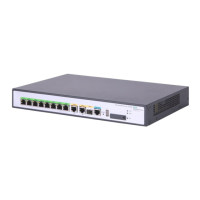167
server-name: Specifies a portal Web server to be referenced on the interface by its name, a
case-sensitive string of 1 to 32 characters. The name must already exist.
fail-permit: Enables the portal fail-permit function on the interface. The portal fail-permit function allows
portal users to access the Internet without authentication when the portal Web server is unreachable.
Usage guidelines
You can enable both IPv4 and IPv6 portal authentication on an interface. Therefore, you can reference
both an IPv4 portal Web server and an IPv6 portal Web server on the interface.
When portal fail-permit is enabled for a portal authentication server and a portal Web server on the
interface, portal authentication is disabled for users on the interface if either server is unreachable. Portal
authentication resumes after both servers become reachable.
Examples
# Reference portal Web server wbs on interface GigabitEthernet 2/1/1 for portal authentication.
<Sysname> system-view
[Sysname] interface gigabitethernet 2/1/1
[Sysname-GigabitEthernet2/1/1] portal apply web-server wbs
Related commands
• display portal interface
• portal fail-permit server
• portal web-server
portal delete-user
Use portal delete-user to log out portal users.
Syntax
portal delete-user { ipv4-address | all | interface interface-type interface-number | ipv6 ipv6-address }
Views
System view
Predefined user roles
network-admin
Parameters
ipv4-address: Specifies the IP address of an IPv4 portal user.
all: Specifies IPv4 and IPv6 portal users on all interfaces.
interface interface-type interface-number: Specifies an interface by its type and number. If you specify
this option, this command logs out all IPv4 and IPv6 portal users on the interface.
ipv6 ipv6-address: Specifies the IP address of an IPv6 portal user.
Examples
# Log out the portal user whose IP address is 1.1.1.1.
<Sysname> system-view
[Sysname] portal delete-user 1.1.1.1

